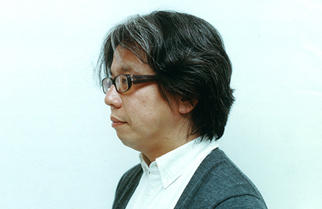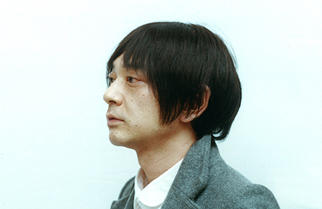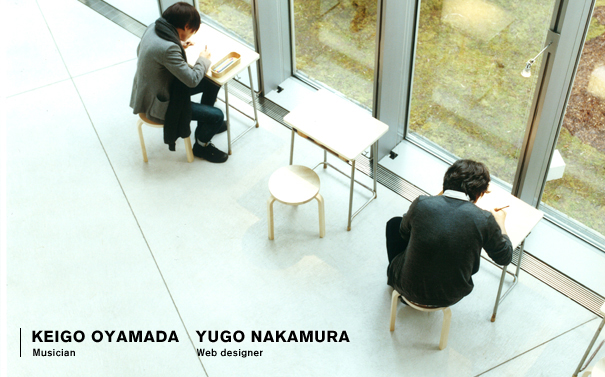
22 Yugo Nakamura (Web designer)×Keigo Oyamada (Musician)
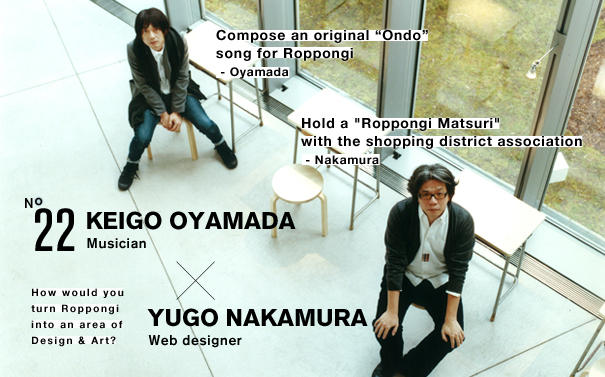
The "Design Ah!" Exhibition is being held at 21_21 DESIGN SIGHT until June 2. It is an experience-oriented exhibition based on the popular TV program "Design Ah!" - an educational program that seeks to encourage children to think about designs. The program won the Good Design Grand Award in 2012. Both Yugo Nakamura, image director of the TV program, and Keigo Oyamada (Cornelius) who is in charge of the music, were also involved in overseeing the "Design Ah!" Exhibition, together with graphic designer, Taku Satoh, its overall director. Asking them to come away from the exhibition venue for a while, we interviewed them on their views on Roppongi.
Creating a top-class environment without making pronouncements
NakamuraHow to turn Roppongi into an area of design and art... what a big topic. Oh dear, I have no idea. (laughs) I didn't even know until now that there was a move to make Roppongi into an area of design and art.
Maybe this is a blunt thing to say, but perhaps it might not be a good idea to verbalize your intention. I mean, Paris doesn't loudly proclaim itself to be a city of art. Corporations which are truly global don't describe themselves as being global.
OyamadaThat's true. I think making pronouncements might put people off.
NakamuraInstead of verbalizing it, I think you should give people a vague idea of what Roppongi is like. With art, people have their own very different ways of interpretation, so I think you should refrain from saying "this is art" or "this is an art town", but make people see that Roppongi has an environment that is wonderfully supportive of art. I think it's important to create that kind of genuine, top-class environment.
"21_21 DESIGN SIGHT" is in a splendid place - it's rare to have such a wide expanse of lawn and greenery in the middle of the city. And there are museums and galleries within Tokyo Midtown itself... these are the attractive aspects of Roppongi that ought to be made known. I can see that it's not easy to get the message across though. At the moment, Tokyo Midtown seems to be a newly built town that is nice but isolated, standing there by itself.
OyamadaI think that in Roppongi, all the facilities are rather far apart from each other. There's quite a distance between Roppongi Hills and Tokyo Midtown, isn't there? Between those two points is the entertainment area behind Almond, and it seems as if a link is missing between this point and that point.
NakamuraIt would be nice if the various facilities could gradually blend in with their surroundings. But I think that creating an atmosphere where people can feel the continuity with Roppongi of the past is something that will take a long time.
I love Asakusa; when I go there for the "matsuri" (festival) or firework festivals, I find there's such a strong sense of community in the neighborhood. It's not possible for me to become a part of that, but I just think it's a lovely town.
Oh, a thought just came to me - why not hold a matsuri?
OyamadaA matsuri?
NakamuraA "Roppongi Matsuri".
OyamadaDoesn't Roppongi already have a matsuri?
A "mikoshi" and an "ondo" song for the local festival
Nakamura In Azabu-Juban, there's the famous Noryo Matsuri. In Roppongi, there's the Roppongi Art Night and the Japan Media Arts Festival whose main venue is the National Art Center, Tokyo. So artists get together at those events, but it would be good if there was a matsuri where the locals could come together too. Come to think of it, the festival for the artists and the matsuri for the locals should probably merge. It would be nice to have a sort of matsuri where people from the shopping district association sell fried corn cobs in the stalls and young black men sell hotdogs.
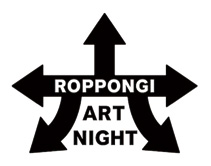
Roppongi Art Night
Roppongi Art Night, the all-night art festival held in Roppongi, will be held this year on March 23-24. The festival's art director is Katsuhiko Hibino, whom we interviewed for this Roppongi Future Talks' previous session.
Oyamada I'm from Tokyo's Setagaya city. I like the matsuri held in the Setagaya quite a lot and I go about three times a year.
Nakamura Indeed. Do you also attend your child's kindergarten events?
Oyamada Yes. I do things like pound the "mochi" (rice cakes). You go to such events too, don't you, Shingo-san?
NakamuraOf course, I go to such events too. I've participated in sports events and run with marshmallows in my mouth. (laughs) It's a lot of fun. If you are interested in matsuri, I wonder if you would compose an "ondo" (traditional Japanese folk dance music) song?
OyamadaA Roppongi Ondo. Yes, alright.
Roppongi evokes the image of the discos in the entertainment area, but I wouldn't be very interested in making a disco-like melody. An ondo should sound like an ondo.
NakamuraThat's great. I'd be in charge of the "mikoshi" (portable Shinto shrine) then. I'd be glad to do all kinds of things like projection mapping.
I think the important thing is reach a wider audience. The 21_21 DESIGN SIGHT has this image of being a smart and sleek place, but in planning the "Design Ah!" Exhibition, we hoped to make it a place where children could get together and play. I really hope that this place will reach a wider range of people and help to expand their thoughts on design.

A sturdy beauty and Roppongi WAVE
NakamuraI first came to Roppongi as a college student when I started living in Tokyo. I would sometimes come here for the drinking parties. There was a favorite ramen shop of mine called Tenho. I now come about four times a week to Roppongi for work. I come to Tokyo Midtown because that's where the Uniqlo headquarters are. Every time the taxi reaches the office building, there's this pretty girl waiting at the porte cochere who opens the door for me. She has a cute face and a sturdy body, so at my office, I refer to her as the "sturdy beauty" and always look forward to seeing her.
OyamadaA long time ago, I used to live in Roppongi. I lived here for about three years when I was in my mid-twenties in a place where the Roppongi Hills now stands. At that time, there used to be a record shop called "Roppongi Wave." I was a complete night person then, so I would wake up in the afternoon, buy a record at WAVE, have a meal at an eatery nearby, and then go home. And in the middle of night, I would go to the Aoyama Book Center and browse books. That's the kind of life I led.
NakamuraI used to go to WAVE a lot too.
OyamadaIt was a nice place, wasn't it? I chose to live in Roppongi because it was convenient for going to Ebisu where I often had work, but it was also because of WAVE and the Aoyama Book Center which was open until the morning.

WAVE
A record shop which opened in 1983 and became a place for transmitting music and all kinds of culture. With the redevelopment of the Roppongi district, the shop was closed in 1999, much to the chagrin of its patrons.
Where you live is the place you like
NakamuraMy favorite town is Sannomiya in Kobe City, Hyogo Prefecture where I spent my junior high and senior high school days. My family lived in Itami, but because my school was in Kobe, I used to often wander around Sannomiya. There was a shopping arcade in the middle of Sannomiya; while there were major shopping complexes like Daimaru, there were also small Mom-and-Pop restaurants right nearby; it was a compact place filled with all kinds of people. There seemed to be a distinct culture there - sort of like what you would get from merging the new facilities of Roppongi with the old Roppongi.
OyamadaI'm from Setagaya and still live there, so my favorite town would be Setagaya. It's convenient and comfortable.
NakamuraSo we both agree that we like the towns we grew up in.
OyamadaI've traveled to many cities but I think the reason you stay in a certain place is because you like it there.
NakamuraExactly. It's interesting travelling abroad, but when you come back, you feel that Japan is definitely the place to be. The economy might sink, but I would not want to budge from this country. I once stayed in Venice, Italy for workshop projects; everyone was so friendly and they would take me to the bars at night, and we would make a racket, but in my heart, I felt so homesick! (laughs)
When you're in a foreign country, you notice various details that you make you feel uncomfortable - like the weird smell of supermarkets. But when you're in a supermarket in Japan, you see that in many ways this is a rich country - there are so many different types of juices for example.
OyamadaI know what you mean. And the warm "oshibori" (hand towels) that are served at restaurants are fantastic, aren't they? Japanese oshibori are sublime!

Things of interest at work
NakamuraI'm interested in the concept of images in everyday life - images that are not actually art works but are a hybrid of graphics and movies. In 2012 we started making framed devices called "FRAMED". They are interior objects for appreciating digital art in everyday life; I'm making images which are like scroll paintings and which keep subtly changing.
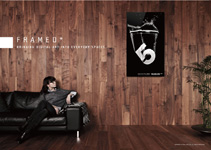
FRAMED*
A new interior device for displaying digital art. It can be used to decorate rooms in the same way as a painting or an art object. A wall-hanging version and a standing version in two different heights are available.
OyamadaWhat interests me in work is thinking about how I can do it as easily as possible. I'm always thinking about how to enjoy myself and be without stress.
NakamuraOh, yes, that's a state I would like to be in as well. There are times when I make it difficult for myself. I seem to make things complicated on purpose and later regret it, or I make too many demands on the staff and the work ends up not being good... I realize that when you are working with other people, it's important to create a good flow. Come to think of it, Taku Sato-san, the director of "Design Ah!" Exhibition is very good at doing that.
During the meetings for the TV program, Taku-san would be so responsive to our ideas, saying "That's great! Let's do it!" He becomes excited in a good way. At first I was a bit hesitant, wondering if he really meant it, but I gradually found myself being enlivened and giving ideas with the sole aim of hearing him say "great!"
OyamadaWhen working on commercials for example, and people say "no" to you for weird reasons, it can get depressing. But in our work for "Design Ah!", we haven't had that kind of experience.
NakamuraTaku-san's ordinary response is "Oh, that's good." and his utmost praise is "You're a genius! This is revolutionary!" When he says that, you think, I started a revolution today! and feel so elated. I am so fortunate to be working on "Design Ah!"
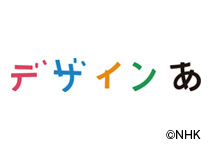
NHK E Tele "Design Ah!" program
A TV program broadcast by NHK E Tele channel. An educational program that aims to encourage children to think about the various aspects of design in the hope that their appreciation will lead to a better future.
From blasting sounds to salmon roe, come enjoy the exhibition!
NakamuraFor the "Design Ah!" Exhibition, we tried to make something that was a fusion of a playground and a TV program. We are not showing works that are usually thought of as being worthy to show at exhibitions and art events - edgy works that are obviously artistic. Instead, we focused on displaying things that are fun, and that could be touched and felt. The tough and yet interesting challenge was in striking a balance between this fun aspect and the fact that this is an exhibition.
OyamadaThe building of "21_21 DESIGN SIGHT" is made of concrete, so we had some difficulties with the reverberating sound, but Nakamura-san originally intended the "Room of things, sounds and images" in Gallery 1 to have blasting sounds, so I think it all went well.
NakamuraI thought that they might lower the sound volume during the exhibition, so I set the initial volume quite high. It's something that people will argue about - like the never-ending debate over the temperature of the air conditioner. (laughs)
OyamadaEach of the exhibition works are good. In the "Five themes", there's a work called "Observation of books" where the titles of classical books have been altered. I think that one is superb.
NakamuraI like the salmon roe in the "Observation of sushi" and the "Ana"(hole). The plastic samples of salmon roe and tuna have been made by a craftsman who is the number one master in his profession.
OyamadaRight. The tuna is so life-like, looking as if it has been freshly cut. I really hope that people will come and look at it. This is an exhibition for using your eyes, ears and hands. I hope everyone enjoys it!
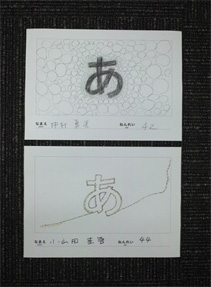
(above) Yugo Nakamura's drawing of "Ah" (below) Keigo Oyamada's drawing of "Ah"
Editor's thoughts
The interview was held just one day before the start of the "Design Ah!" Exhibition and Nakamura-san and Oyamada-san understandably had their minds occupied with the exhibition. While they work in different fields, they had a very animated conversation, and it seemed to me to show how design has the power to bring people together. (edit_rhino)




